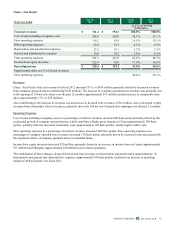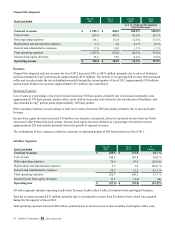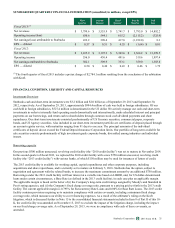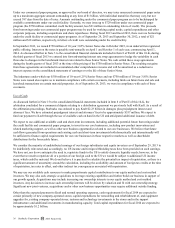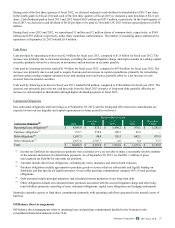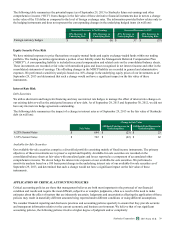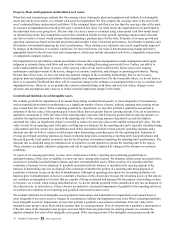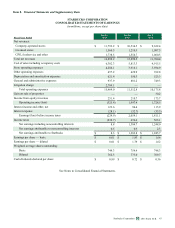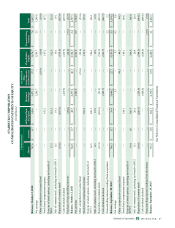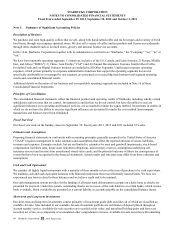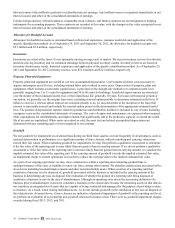Starbucks 2013 Annual Report Download - page 49
Download and view the complete annual report
Please find page 49 of the 2013 Starbucks annual report below. You can navigate through the pages in the report by either clicking on the pages listed below, or by using the keyword search tool below to find specific information within the annual report.
41
implied estimated fair value, an impairment charge is recorded to reduce the carrying value to the implied estimated fair value.
Fair value is the price a willing buyer would pay for the intangible asset and is typically calculated using a discounted cash
flow model. Key assumptions used in this calculation include revenue growth, the royalty rate that could hypothetically be
charged by a licensor of the asset to an unrelated licensee and a discount rate that we believe reflects the level of risk associated
with receiving the future cash flows attributable to the asset. Estimates of revenue growth are based on internal projections
considering the intangible asset group's past performance and forecasted growth. The royalty rate used is based on observed
market royalty rates for similar licensing arrangements adjusted for our particular facts and circumstances. The discount rate is
calculated using an estimated cost of capital that reflects the risk profile of the related business. These estimates are subjective
judgments and can be significantly impacted by changes in the business or economic conditions.
Our impairment loss calculations contain uncertainties because they require management to make assumptions in the
qualitative assessment of the reporting unit or intangible asset group and require management to apply judgment to estimate the
reporting units or intangible asset group's fair value, including estimating future cash flows, and if necessary, the fair value of a
reporting units’ assets and liabilities. Further, our ability to realize the future cash flows used in our fair value calculations is
affected by factors such as changes in economic conditions, changes in our operating performance, and changes in our business
strategies. During the past three fiscal years, we have not made any material changes in the accounting methodology that we
use to assess impairment loss. For fiscal 2013, we determined the fair value of our reporting units and intangible asset group's
were substantially in excess of their carrying values. Accordingly, we did not recognize any goodwill impairments during the
current fiscal year. We do not believe there is a reasonable likelihood that there will be a material change in the estimates or
assumptions that we use to test for impairment losses in the foreseeable future. However, as we periodically reassess our fair
value calculations, including estimated future cash flows, changes in our estimates and assumptions may cause us to realize
material impairment charges in the future.
Income Taxes
We recognize deferred tax assets and liabilities based on the differences between the financial statement carrying amounts and
the respective tax bases of our assets and liabilities. Deferred tax assets and liabilities are measured using current enacted tax
rates expected to apply to taxable income in the years in which we expect the temporary differences to reverse. We routinely
evaluate the likelihood of realizing the benefit of our deferred tax assets and may record a valuation allowance if, based on all
available evidence, we determine that some portion of the tax benefit will not be realized.
In addition, our income tax returns are periodically audited by domestic and foreign tax authorities. These audits include review
of our tax filing positions, including the timing and amount of deductions taken and the allocation of income between tax
jurisdictions. We evaluate our exposures associated with our various tax filing positions and recognize a tax benefit only if it is
more likely than not that the tax position will be sustained upon examination by the relevant taxing authorities, based on the
technical merits of our position. For uncertain tax positions that do not meet this threshold, we record a related liability. We
adjust our unrecognized tax benefits liability and income tax expense in the period in which the uncertain tax position is
effectively settled, the statute of limitations expires for the relevant taxing authority to examine the tax position, or when new
information becomes available.
Income generated in certain foreign jurisdictions has not been subject to US income taxes. We intend to reinvest these earnings
for the foreseeable future. If these amounts were distributed to the US, in the form of dividends or otherwise, we would be
subject to additional US income taxes, which could be material. Determination of the amount of unrecognized deferred income
tax liabilities on these earnings is not practicable because such liability, if any, is dependent on circumstances existing if and
when remittance occurs.
Deferred tax asset valuation allowances and our liability for unrecognized tax benefits require significant management
judgment regarding applicable statutes and their related interpretation, the status of various income tax audits, and our
particular facts and circumstances. Although we believe that the judgments and estimates discussed herein are reasonable,
actual results could differ, and we may be exposed to losses or gains that could be material. To the extent we prevail in matters
for which a liability has been established, or are required to pay amounts in excess of our established liability, our effective
income tax rate in a given financial statement period could be materially affected.
Litigation Accruals
We are involved in various claims and legal actions that arise in the ordinary course of business. Legal and other contingency
reserves and related disclosures are based on our assessment of the likelihood of a potential loss and our ability to estimate the
loss or range of loss, which includes consultation with outside legal counsel and advisors. We record reserves related to legal
matters when it is probable that a loss has been incurred and the range of such loss can be reasonably estimated. Such
assessments are reviewed each period and revised, based on current facts and circumstances and historical experience with
similar claims, as necessary.
2013 10-K
Starbucks Corporation Form




